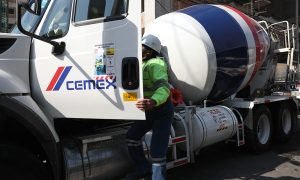Over and above heavy lift
Meet the people that are ready to go over and above the call of duty to ensure that construction equipment reaches the most dangerous and remote of locations. Jonathon Savill writes When you make a list of construction machinery Antonov may not be top of your list, however in many instances aircraft may be the […]


Sometimes aircraft may be the only way of getting machinery, and sometimes manpower, to a difficult site
Meet the people that are ready to go over and above the call of duty to ensure that construction equipment reaches the most dangerous and remote of locations. Jonathon Savill writes
When you make a list of construction machinery Antonov may not be top of your list, however in many instances aircraft may be the only way of getting machinery, and sometimes manpower, to a difficult site.
Ian McEwan is an aviation expert. His CV includes three thousand hours as a pilot, some of it on DC3s. He is a loadmaster and expert in aviation operations. Oh, and he was also the aviation consultant to the recent James Bond movie, Skyfall. What you would call a great all rounder.
On average he moves one load a month, which, either heavy, dangerous or just plain difficult. His is a world of fraught late night phone calls with requirements to find extraordinary items late at night with no time. In case you’re wondering what heavy loads constitute it’s around 180 tons or so. For that you’ll need an Antonov 225, which can carry 180 tons single piece load.
The heaviest piece it’s ever had to carry so far is around 160 tons. Dimensions of this load are 48 metres long by 6.8 metres wide by 4.4 metres high. You can carry eight articulated trucks, tractor and trailers. It’s a lot of carry.
The smaller brother, the Antonov 124, can carry six trailers and two tractor units. The Russians and Ukrainians are the heavyweight champions of the world. The 124 was originally designed to carry intercontinental ballistic missiles, that’s why it’s so long and thin.
The aircraft can be loaded from the front or the rear but its party piece is the ability to kneel. It lowers itself onto special jacks and can bring the load deck right down to the floor to enable long difficult loads to be brought onboard.
The other thing about Antonov is that they have internal cranes in the aircraft’s body. They have four overhead cranes, each with five tons carrying capacity. Not only that but the cranes extend to the point where you can back in a forty foot trailer to offload underneath the plane.
In case you’re thinking of dong this you can hire the 124 for around $20,000 an hour. The 225 is unique and therefore costs a lot more. How much?
“Expensive, very expensive” McEwan answers with a grin. Ruslan in Stansted are the operators of this aircraft.
They are incredibly thirsty (around eight tons of fuel an hour) because they are carrying heavy loads. In fact they are a fairly hefty load themselves, at roughly 200 tons.
If your tastes run more to helicopters, allow us to introduce the MI26, again a Russian made helicopter. This can carry a single lift under slung load of up to 20,000 kilos, or twenty tons. So it can hang an eighteen-ton bulldozer underneath. Or it can open its back doors and you can drive a JCB inside it.
A lot of these planes operate in dangerous places. The operators charge war risk insurance, which is charged on a trip by trio basis. This is calculated on the risk at destination, calculated on a more or less live basis.
Most of the clients for these aircraft are oil and gas or military. They are especially useful for tracked vehicles such as tanks (or bulldozers of course). Deployments for the European forces into Afghanistan were mostly done with Antonovs. Of course they have the C17 but when they need to move a lot of people they call up the Antonov boys.
Most of the crews are from Eastern Europe. When Russia effectively collapsed the Russians found themselves with some left over planes and nothing to do with them. So they started flying heavy loads. The aircraft are maintenance intensive but the maintenance is carried out in Eastern Europe.
McEwan spends a lot of time doing jobs which are time sensitive: “Obviously if they can move it by sea it is around twenty percent of the cost of air. But of course a lot of countries are land locked too.”
Jobs don’t always go smoothly: “A few months ago I was asked to move a tool basket from Aberdeen to Georgia. It was required because they had got a drill bit stuck and needed a tool to free it. The production from this unit had stopped and it was costing thousands of dollars an hour while it was stopped. They loaded it into a plane.
“It weighed about six tons but it was long and awkward. We chartered an Antonov because it would not fit into a normal plane. We flew it immediately via Bulgaria and Tbilisi then flew into a site in the middle of nowhere.”
He continues: “Twenty years earlier they had used a grader to make the runway but it had been abandoned at the business end of the runway and there were trees growing out if it. We landed in a cloud of red dust and it was like we’d landed on the moon. All you could see was red dust and there wasn’t a soul to be seen. It was more like Russian tundra than Georgia.”
“We sat and waited. Eventually a really old beaten up Russian pickup truck arrived and the window wound down. A really broad Scots accent said ‘Have you just come from Aberdeen?’ When I nodded he said ‘Have you got a Press and Journal?’ that’s the local paper from Aberdeen. I’m an experienced aviation expert so I had brought two copies. So he was happy.”
McEwan now had a problem because they had a truck, but not the requested heavy lift crane. The solution was pragmatic rather than elegant. They joined the machine on the plane to the grader with a long wire.
They then covered the deck behind the toolbox with oil and the captain taxied away under something approaching full power.
Nature and gravity worked together and the tool basket ended up on terra firma – delivered according to contract.
These aircraft have huge crews. The Antonov 124 has a crew size of twelve to fourteen people. They actually have one engineer per engine. Given the nature of aircrews you can imagine you would not want to be the engineer who had an engine fail, so their reliability rate is high.
A lot of his work involves disaster recovery.
“When the Tsunami happened we used lots of aircraft to bring in manpower and equipment. In Puerto Rico after Hurricane George I was personally involved in running three Antonov 124 aircraft back to back,” explains McEwan. “We were flying in tankers to replenish the water supplies but also telegraph poles. Lots of the telegraph poles snapped and in the Caribbean they use these to carry power as well as phone cables.
“We also had two 747’s running back to back from Atlanta flying in hundred ton loads of ice cubes. Forty-foot trucks were driving to the factory and then teams of guys with gloves made igloos on the cargo deck.
“Nothing melts at 40,000 feet. When you get to the other end you load it into refrigerated containers and you have drinking water. The ice also gets used in the hospitals, you can’t run a hospital without fresh water.”
I ask McEwan what advice he would give to any contractor considering using his services. He is definite and quick in his response “Get us involved right at the start.
“Take advice on the size of loads, and how you can get them to the aircraft,” he remarks. “One contractor chartered four aircraft and arrived with every load one metre too big to go into the aircraft. Everything had to go by sea and it took four months to get it to the project.”



















